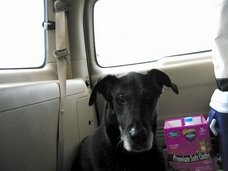10. Use a different route on the return trip.
Loops double the excitient of almost any road trip. If you're looking at the same stuff (only backwards) that you looked at when you set out on your adventure, the message to the kids will be clear: We're done, we're going home now, the fun is over. Don't let the return trip cut your vacation short.
Here's a fun loop to Glacier National Park from Missoula, MT.
The Sealy Lake and Swan Lake Vallley is a great return route after heading north into the Mission Valley. Stay the first night in Big Fork and head out first thing in the morning to Glacier. Stay a night or two in the park, and head out to Whitefish for a night and then drive back to Missoula through the Sealy/Swan Valley. And look for the Giant cow where 83 meets 200.
The history of the mountains is really neat along this loop. Like the rest of the rocky mountains, these mountains were formed by earthquakes, and then shaped by glaciers. The Mission mountains are the face of a huge fault line that FAULTED (7.5). Whith a drastic drop, the Missions were formed. But the cool part comes up later in their life; when they met the big glacier of the north. The glacier, which filled the rocky mountain trench (it extends up through British Columbia and into the Yukon) flowed south carving a valley with it until it reached the Mission Mountains. There was a flurry of excitement, but eventually, a compromise was reached. The great compromise consisted of two parts:
1. The Mission Mountains would split the glacier in two, forcing it to fork down the Mission valley and the Sealy/Swan valley
2. The glacier could take as much of the Mission Mountains with it as it could carry.
And so it did, down to around Ronan. That's why the Mission Mountains north of Ronan are very round, (because the glaciers covered then and rounded their tops) and the mountains south of Ronan are so jagged (because the big glacier didn't make it that far).
Read this great article A Freak Preserved by an Accident: The Making of Flathead Lake. It was written by one of my old Geology professors, Dave Alt.
skip to main |
skip to sidebar
Click here to meet the family!

She logged a lot of miles with us (photo by Tommy)
A Road Map for Peace-ful Family Travels: Teach your kids about the United States by driving America's backroads and city centers. Games, tips, and tactical advice for adventure road trips with kids and dogs.
Take Our 30-Second Survey!
If you tell us about your family travels, we can write stuff that'll be more useful and interesting to you.
Five questions, 30 seconds, get a free barf bag!
Click please!
Five questions, 30 seconds, get a free barf bag!
Click please!
Stuff we write about
10 Tips for Road Tripping with Kids
(10)
Alabama
(2)
American Backroads: Northeast
(11)
American Backroads: Southeast
(7)
American Backroads: west
(8)
City Guides
(12)
Connecticut
(3)
Dinosaur trail
(1)
Disney World
(3)
Dog Blogs
(5)
Find This Place
(6)
General Travel Tips
(9)
Ghost of Road Trips Past
(5)
Guest Bloggers
(4)
Holiday Travel
(3)
Leaf Peeping Tips
(5)
Lighthouses
(3)
Maine
(19)
Make learning fun
(11)
Map of Shame
(1)
Maps
(22)
Massachusetts
(2)
Miscelaneous stuff
(4)
Mississippi
(4)
montana
(3)
More Tips for Traveling with Kids
(21)
Natchez Trace
(9)
Nebraska
(1)
Nevada
(1)
New England
(17)
New Hampshire
(5)
New Mexico
(1)
New York
(3)
Oregon
(2)
Road Trip Word Games
(4)
Route 66
(1)
Take Great Photos of Your Kids
(2)
Tennessee
(2)
Texas
(1)
Thumbs Up List
(4)
Vermont
(4)
Video Blogs
(2)
Wacky Festivals
(1)
Washington DC
(3)
Photo Tips
How will the recession affect your family vacations?
Tom"s Blog
Meet the Road Trippers!
www.flickr.com
This is a Flickr badge showing public items from Family Road Trippers tagged with roadtripper. Make your own badge here.
The Late Great Elke

She logged a lot of miles with us (photo by Tommy)
Family Travel Blog Roll
Helpful Road Trip Links
- Cracker Barrel -- very kid friendly
- DogFriendly.com
- Fodor's forum
- Fuel cost calculator
- Gas Buddy.com
- Google Maps
- Hampton Inn's Hidden Landmarks
- Residence Inn (dogs allowed, free breakfast)
- Roadside America -- fun stuff everywhere
- Saving Money on Road Trips -- The Simple Dollar
- Speed Traps
- State speed limits
- Weather.com
Browse the archives
-
▼
2007
(61)
-
▼
January
(12)
- Kid-Friendly City Guide to Washington DC
- Tips for Road Tripping with Kids (#10)
- Tips for Road Tripping with Kids (#9)
- Tips for Road Tripping with Kids (#8)
- More Road Trip Word Games
- Great Drives West of the Mississippi: New Mexico
- Simple Rules for Lousy Photos of Kids (2)
- Make Learning Fun on a Family Road Trip
- Tips for Road Tripping with Kids (#7)
- Are We There Yet?
- Tips for Road Tripping with Kids (#6)
- Tips for Road Tripping with Kids (#5)
-
▼
January
(12)




No comments:
Post a Comment